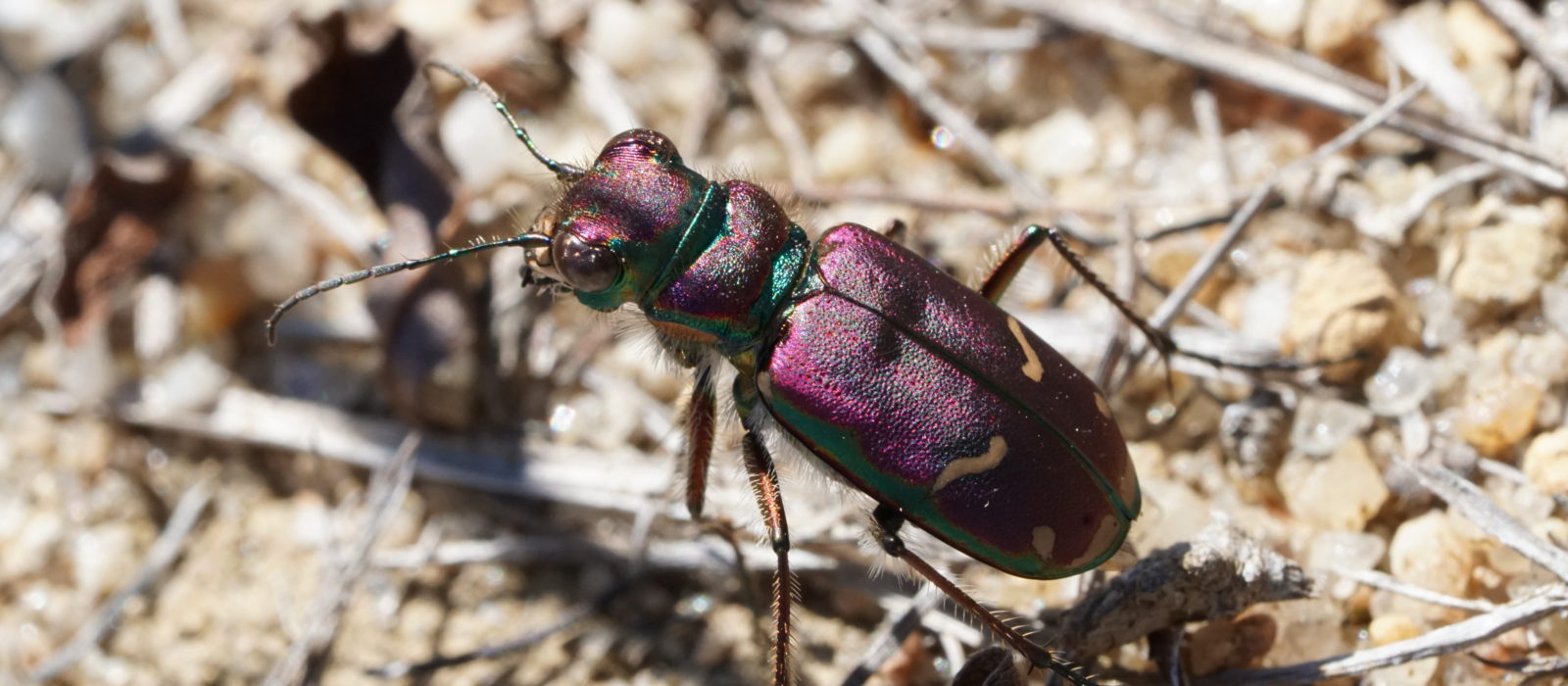TIGER BEETLES: CICINDELINAE
Treated variously as a family of their own, Cicindelidae, or a subfamily, Cicindelinae, within the ground beetles (Carabidae), these cursorial predatory beetles are found nearly all over the world, primarily in temperate and tropical climates. We follow iNaturalist in considering this group to be a subfamily. As a group, these beetles inhabit a wide range of open habitats. About the only restriction on habitat is that the soil must be friable enough for burrows to be dug without difficulty; loose and sandy soils seem to be the most commonly occupied. About 2000 species are known worldwide and 150 in North America (Roscoe, 2001), 24 in the six New England states and maritime Canada, and 18 in Massachusetts (Leonard and Bell, 1999). Included among the 24 New England species are two vagrants from south of that area, one found in Connecticut and one found on Nantucket.
These are predatory insects, both as adults and as larvae. Adults can fly well and when disturbed typically fly a few yards and land, often facing the disturbance. But they usually run down their prey. Opportunistic foragers, they take a wide range of arthropods. The larvae are ambush hunters that dig vertical burrows into the soil; the insect’s head forms the “lid” at the opening. Any prey species that comes within reach is captured and dragged into the burrow for consumption. “Summer” species emerge as adults, breed and die in summer while “spring-fall” species emerge as adults in late summer or fall, over-winter, then breed and die the following spring.
Life history and ecology of these fascinating but vulnerable insects are given by both Leonard and Bell (1999) and by Roscoe (2001). The only field guides we know of are Pearson et al. (2006), which covers all species that occur in the United States, and Leonard and Bell (1999) which covers the northeastern part of the country.
Several of our species are common and easily found in appropriate habitat; others are scarce or restricted to very specific settings. Of particular significance is the Northeastern Beach Tiger Beetle, Habroscelimorpha dorsalis dorsalis. Martha’s Vineyard hosts the only native population of this taxon left in New England. It apparently once occurred from Cape Cod south to Virginia but has now been extirpated from most of that area. An ongoing project is attempting to establish a viable population at Monomoy National Wildlife Refuge. See Vogler and Desalle (1994) and Goldstein and Desalle (2003) for a discussion of conservation management approaches and of DNA analysis of historical populations of this species, respectively.
Recent records are scarce or altogether lacking for several species, which may reflect either limited observer effort or extirpation. Encouragement may be found in the rediscovery of Cicindela formosa in 2021 after many years with no reports of this species. The numbers of tiger beetles present in any habitat type can vary widely by season and by time of day, so the information on abundance in the accompanying checklist must be understood in that light. The geographical ranges of the 11 species known for Martha’s Vineyard include most of New England and southern portions of maritime Canada except for Elipsoptera marginata and Habroscelimorpha dorsalis dorsalis, the ranges of which do not reach quite so far north. Thus to a very modest extent, the island’s tiger beetles have a slight southern geographical affinity.
Allan Keith; edited by Matt Pelikan, November 26, 2021
References:
Goldstein, P.Z. and R. Desalle. 2003. Calibrating phylogenetic species formation in a threatened insect using DNA from historical specimens. Molecular Ecology 12:1993-1998.
Leonard, J. G. and R. T. Bell. 1999. Northeastern Tiger Beetles. CRC Press, New York. 176 pages.
Roscoe, L. 2001. The tigers in our midst. Massachusetts Wildlife 51(3):10-21
Vogler, A. P. and R. Desalle. 1994. Diagnosing units of conservation management. Conservation Biology 8(2):354-363
Web Resources:
https://www.inaturalist.org/guides/13576 An identification guide for Vineyard tiger beetles prepared by BiodiversityWorks.
